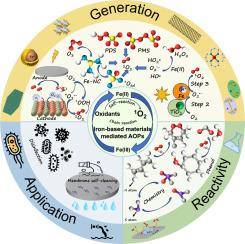Singlet oxygen (1O2) generation mediated by iron-based materials: Mechanisms, activation pathways and applications in wastewater treatment
IF 23.5
1区 化学
Q1 CHEMISTRY, INORGANIC & NUCLEAR
引用次数: 0
Abstract
Singlet oxygen (1O2) is regarded as a promising decontamination agent in practical wastewater treatment owing to its strong resistance to water matrix interference. Iron-based materials exhibit high catalytic activity and reaction selectivity in advanced oxidation processes (AOPs) and have become preferred transition metals for mediating 1O2 generation. However, the mechanisms underlying iron-based material mediated 1O2 generation are complex and vary significantly depending on oxidant types and environmental factors, necessitating a systematic review to guide the design and application of efficient catalytic systems. This study elucidates the technical merits of 1O2 in wastewater treatment by systematically analyzing its molecular characteristics, lifetime, orbital energy, reactive properties and oxidative pathways. 1O2 generation in different oxidation systems such as ozonation, hydrogen peroxide activation and persulfate activation has been summarized. Key driving mechanisms of 1O2 generation mediated by various iron-based materials under different oxidants have been discussed. Enhancement of 1O2 generation efficiency by energy (photocatalytic and electrochemical) assisted activation is demonstrated. Finally, challenges and corresponding countermeasures related to reaction mechanisms, mineralization assessment, real-water applicability and recyclability of 1O2 systems catalyzed by iron-based materials have been proposed. This review examines the utilization of iron-based catalysts in AOPs, aiming to provide new insights for future research on 1O2 generation driven by iron-based materials.

铁基材料介导的单线态氧(1O2)生成:机制、激活途径及其在废水处理中的应用
单线态氧(1O2)具有较强的抗水基质干扰能力,在实际污水处理中被认为是一种很有前途的去污剂。铁基材料在高级氧化过程(AOPs)中表现出较高的催化活性和反应选择性,已成为催化o2生成的首选过渡金属。然而,铁基材料介导1O2生成的机制是复杂的,并且根据氧化剂类型和环境因素而有显着差异,需要系统的综述来指导高效催化系统的设计和应用。本研究通过系统分析1O2的分子特性、寿命、轨道能、反应性质和氧化途径,阐述了其在废水处理中的技术优势。综述了臭氧氧化、过氧化氢活化和过硫酸盐活化等不同氧化体系对o2生成的影响。讨论了不同铁基材料在不同氧化剂作用下催化氧化生成1O2的关键驱动机制。通过能量(光催化和电化学)辅助活化提高了1O2的生成效率。最后,提出了铁基材料催化1O2体系在反应机理、矿化评价、实水适用性和可回收性等方面面临的挑战和相应的对策。本文综述了铁基催化剂在AOPs中的应用,旨在为未来铁基材料驱动的1O2生成研究提供新的见解。
本文章由计算机程序翻译,如有差异,请以英文原文为准。
求助全文
约1分钟内获得全文
求助全文
来源期刊

Coordination Chemistry Reviews
化学-无机化学与核化学
CiteScore
34.30
自引率
5.30%
发文量
457
审稿时长
54 days
期刊介绍:
Coordination Chemistry Reviews offers rapid publication of review articles on current and significant topics in coordination chemistry, encompassing organometallic, supramolecular, theoretical, and bioinorganic chemistry. It also covers catalysis, materials chemistry, and metal-organic frameworks from a coordination chemistry perspective. Reviews summarize recent developments or discuss specific techniques, welcoming contributions from both established and emerging researchers.
The journal releases special issues on timely subjects, including those featuring contributions from specific regions or conferences. Occasional full-length book articles are also featured. Additionally, special volumes cover annual reviews of main group chemistry, transition metal group chemistry, and organometallic chemistry. These comprehensive reviews are vital resources for those engaged in coordination chemistry, further establishing Coordination Chemistry Reviews as a hub for insightful surveys in inorganic and physical inorganic chemistry.
 求助内容:
求助内容: 应助结果提醒方式:
应助结果提醒方式:


